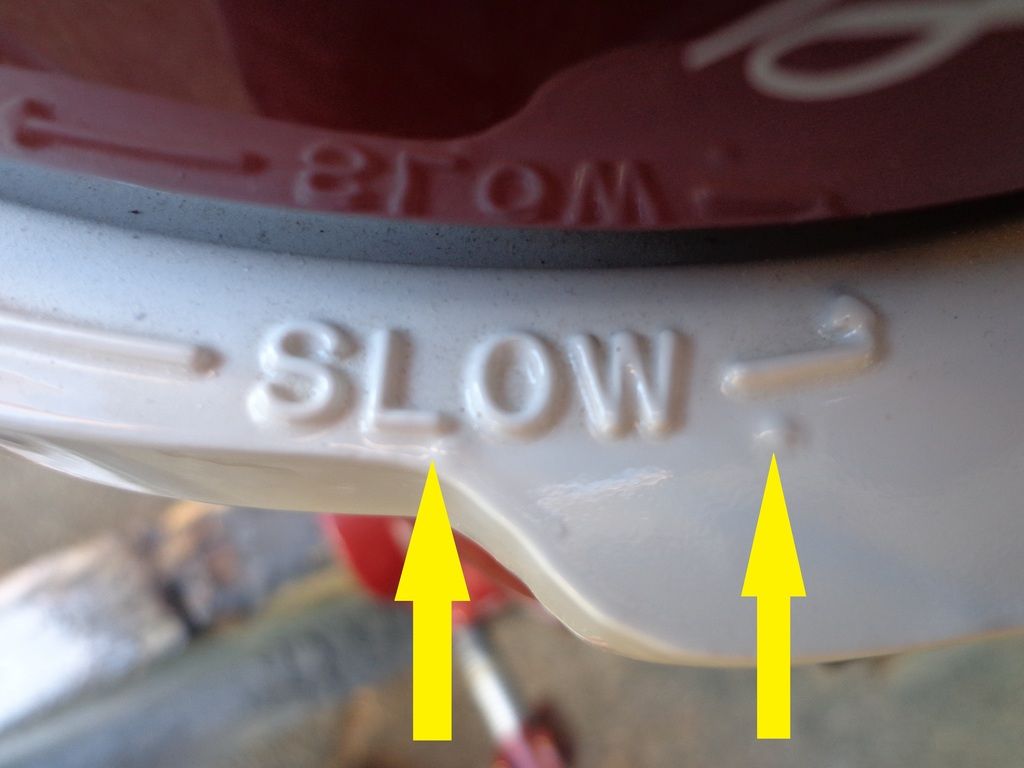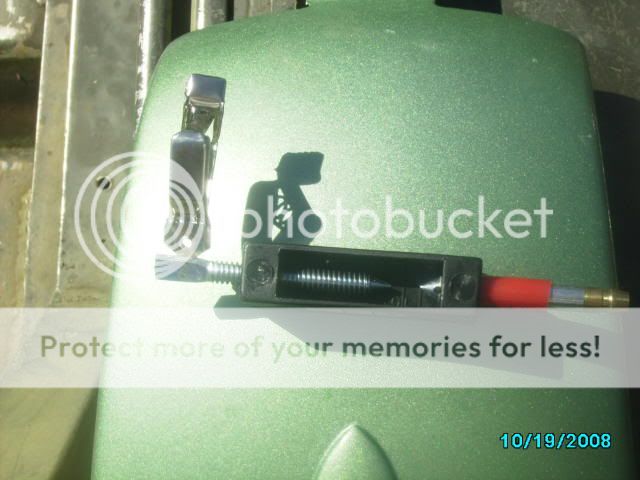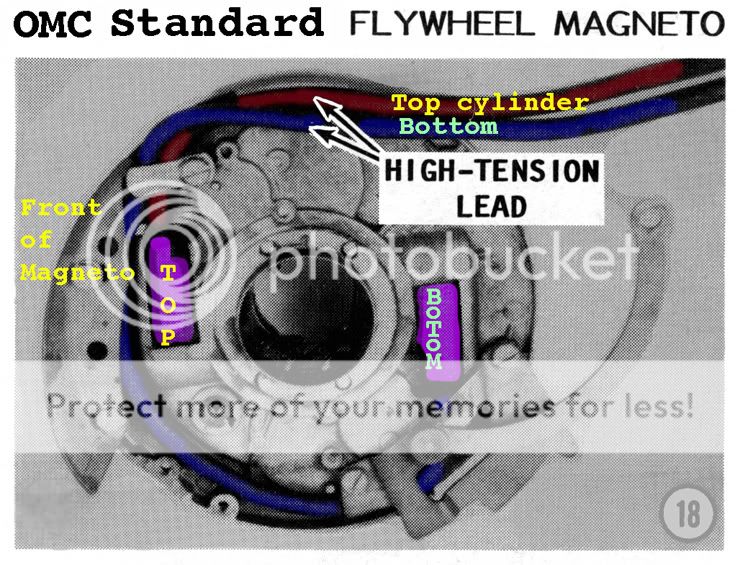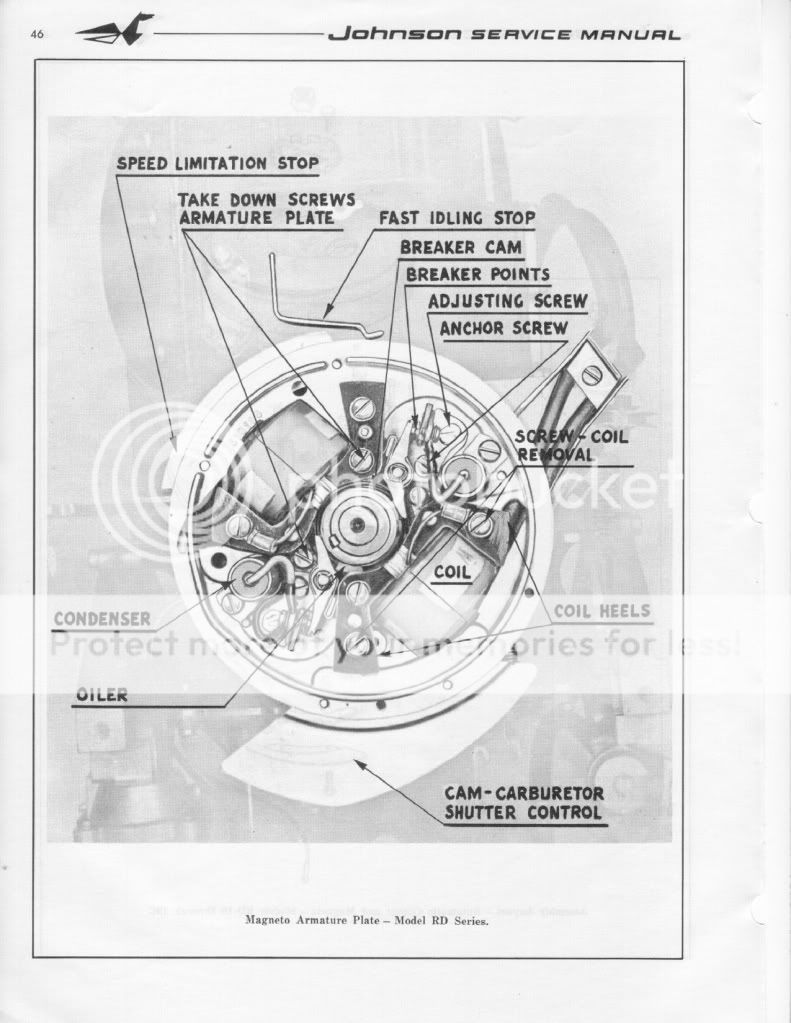Home › Forum › Ask A Member › 1961 Johnson JW won’t run
- This topic has 12 replies, 9 voices, and was last updated 10 years, 4 months ago by
crosbyman.
-
AuthorPosts
-
August 6, 2015 at 12:44 pm #2203
A few weeks ago I acquired a 1962 Johnson JW. I won’t say it’s in mint condition, but it has seen minimal use and I think it has probably less than 100 hours on it.
I cleaned the carb very well (by hand and in an ultrasonic cleaner). It didn’t have any spark, so I pulled the flywheel and of course I found two cracked coils inside. I replaced both coils and I also cleaned and adjusted the points. I don’t have a spark tester, but when I hold the spark plugs against the cylinder head I get a big blue spark on each spark plug everytime I pull the rope. I put the motor in a test tank and I tried to get it running. With my other vintage Evinrude/Johnson outboards I never had to pull more than 10 times to get it running, even if it sat for over 30 years. When I tried to start this little JW I had to pull about 50 times before it fired and when it did, it died immediately. After many more pulls it started up again and I got it running for about 30 seconds at full throttle. It wouldn’t run at less throttle, so I suspected the carb adjustment was off and I tried to adjust it. It didn’t seem to do anything and I couldn’t get it to run any better.
Before I started the tune up on this motor I did a compression test. I got about 70 psi on each cylinder. This was less than I expected, because the motor itself looks so nice! I pulled the spark plugs to look at the cylinder walls and they looked very nice. No scoring whatsoever! I figured those compression numbers would probably go up once I got it running, because it has probably been sitting for a long time.
After I tried to get it running in the test tank, I checked for spark once more and again I got a nice blue spark at both plugs. I decided to do another compression test (when the engine was completely cold) and this time I got 60 psi at both cylinders! I gave the cylinder walls another look and again, they seemed to be in really good shape.What could be the problem with this motor? Could it be the head gasket? I first want some opinions before I pull the head and possibly break some head bolts…
Some things I forgot to mention:
– The carb is getting enough fuel, the gas even drips from the carb (it’s flooding). That was the reason I checked again for spark, because it didn’t seem to burn all fuel from the carb.
– When I tried running it in the test tank I did take the air box off.
– Sometimes it would start (after 50 times pulling) and run for about 30 seconds, only at full throttle. Then, when it died, it didn’t start up for another 50 pulls. Even if I sprayed starting fluid in the intake it didn’t fire. This makes me think the problem can’t be the fuel system.August 6, 2015 at 1:32 pm #21589Pull the exhaust cover off and check for stuck rings
August 6, 2015 at 2:14 pm #21593Frank is right,the only way to really see what is going on there is to pull the exhaust cover off.Even with low compression you might want to check your lync/sync.Move the throttle level all the way to the stop position.Now look where it says slow;you will see two small dots.With the motor cowl off,move the throttle lever to the slow position.When the lever is between these two dots you should see the carb linkage just start to move and open.If it doen’t your timing is off.if the timing is good,then take out the high speed needle and see if the needle is grooved or badly blunted.If the needle looks good then screw it back in to a lightly seated position and turn it out 3/4ths of a turn.This is just a starting point,as I have just finished with a JW10 that will only start and run well with the needle turned out a quarter turn.Good lock
August 6, 2015 at 4:12 pm #21597Well, sounds like your spark is OK. Perhaps there is a restriction in the fuel system/carb causing the engine to be hard to start and only run for a few seconds. On the other hand, perhaps the engine is flooding causing the fuss, you might try running it with the air box off.
70PSI is a fairly normal compression reading for that engine, 60PSI might be a little low. But again, these engines have small combustion chambers, so compression gage accuracy should always be questioned as well. You could always try soaking in engine tuner/seafoam if you want to hold off on pulling the head/exhaust cover. Sounds like your cylinder walls look OK, but your rings could be stuck.August 6, 2015 at 4:51 pm #21601Thanks for your replies!
Some things I forgot to mention:
– The carb is getting enough fuel, the gas even drips from the carb (it’s flooding). That was the reason I checked again for spark, because it didn’t seem to burn all fuel from the carb.
– When I tried running it in the test tank I did take the air box off.
– Sometimes it would start (after 50 times pulling) and run for about 30 seconds, only at full throttle. Then, when it died, it didn’t start up for another 50 pulls. Even if I sprayed starting fluid in the intake it didn’t fire. This makes me think the problem can’t be the fuel system.I took the exhaust cover off and both pistons looked to be in nice shape. The upper piston has some really light scoring, but I’ve seen that on almost every upper piston in my old outboards. I tried to move the rings, but they didn’t move. I also find the rings really tight in the piston and I doubt if there (if the rings are not stuck) would be any free space in the ring grooves for the rings to move. I sprayed some WD40 directly on the rings to soke them, but I didn’t see any carbon build up around the rings.
My compression tester is pretty accurate I think. On other old outboards and lawn mowers I get normal/correct readings…August 6, 2015 at 6:38 pm #21606
VintageOutboardMan, if your ignition is in order, then it should fire off easily with premix shot in the cylinders, even with 60psi of pressure.I would invest in a $6.00 open air spark gap checker. If, it can easily jump 1/4 inch with a nice fat blue spark then your magnets, coils, condenser, and points should be in good shape.
The other component of the ignition is the timing. Things that could effect your timing despite setting the points to 0.02 inches or using a timing fixture. These specific issues will affect timing of the spark. Optimal timing is when spark is produced at the top of the piston stroke igniting the compressed fuel mix/air charge. If spark is produced at other times then there may not combustion or back fire.
– crossed ignition wires. (top on the bottom and bottom on the top spark plugs)
– breaker cam that is up side down. (make sure the word top is facing up)
– movement of the breaker cam (due to damaged cam or key)
– damage key or flywheel key way mating.
– ignition plate slop and movementAugust 6, 2015 at 7:06 pm #21608Here’s the location of the two dots Bob referred to and are used for synchronising the timing of the carb to the magneto. The carb butterfly should just be starting to open with the lever positioned between the dots.
 August 6, 2015 at 7:38 pm #21609
August 6, 2015 at 7:38 pm #21609After re-reading your post. I saw that you stated that it would run for a short period but only at wide open.
Motors that have not been run in a long time or have been kept outside or in open covered area are prone to having wasp nest clogging up the exhaust in the leg. This restricts or prevents good air movement in and out of the crank case and power head. Make sure you remove the lower unit and inspect the upper exhaust leg with a flashlight.
If all is clear, then poor fuel delivery could be due to rusted, broken, stuck reed valves or piston skirt damage causing poor negative crankcase pressure. When you removed your carburetor did you see any rust or coating of rust leading into the crankcase?
August 6, 2015 at 8:27 pm #21612Good thought about a plugged exhaust, the mud dobbers may have moved into the JW!
I’m not sure I am understanding what you are describing, you seem to indicate that the rings are stuck, do I have this right? Can you compress the rings into their grooves with a small screwdriver? I hear ya, most engines have some slight scuffing/scoring here and there.
If the rings are indeed stuck, you may want to center the pistons and fill the plug holes with engine tuner/seafoam with the cylinders in a vertical position.
Does it look like the intake manifold has been off before? Any signs of powerhead disassembly, screws disturbed?August 7, 2015 at 5:31 pm #21658Im with ya on a troublesome JW!
They are usually such easy motors to tune. I put one on the bench this morning that doesn’t want to start either. All new ignition, carb kit, etc…
If I figure mine out Ill let ya know 😉 Sandwich break.
It will run if I mist pre mix into the carb throat for a sec, so thinking it cannot PULL the fuel into the crankcase. The clogged exhaust might be my issue as well as yours?
-
AuthorPosts
- You must be logged in to reply to this topic.




